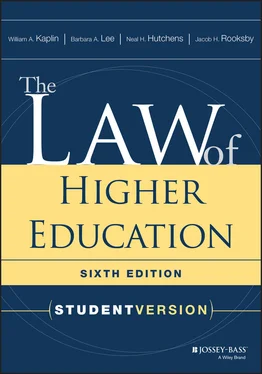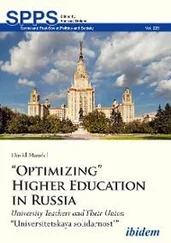The federal Constitution has no provision that specifically refers to education. State constitutions, however, often have specific provisions establishing state colleges and universities or state college and university systems, and occasionally community college systems. State constitutions may also have provisions establishing a state department of education or other governing authority with some responsibility for postsecondary education. A minority of states, including California, Michigan, and Minnesota, have constitutional provisions that establish constitutionally empowered public institutional or system governing boards.
The federal Constitution is the highest legal authority that exists. No other law, either state or federal, may conflict with its provisions. Thus, although a state constitution is the highest state law authority, and all state statutes and other state laws must be consistent with it, any of its provisions that conflict with the federal Constitution will be subject to invalidation by the courts. It is not considered a conflict, however, if state constitutions establish more expansive individual rights than those guaranteed by parallel provisions of the federal Constitution. (See the discussion of state constitutions in Section 1.5.3.)
An abridged version of the federal Constitution, highlighting provisions of particular interest to higher education, is contained in Appendix A.
1.4.2.2 Statutes.Statutes are enacted both by states and by the federal government. Ordinances, which are in effect local statutes, are enacted by local legislative bodies, such as county and city councils. While laws at all three levels may refer specifically to postsecondary education or postsecondary institutions, the greatest amount of such specific legislation is written by the states. Examples include laws establishing and regulating state postsecondary institutions or systems, laws creating statewide coordinating councils for postsecondary education, and laws providing for the licensure of postsecondary institutions (see Section 11.2.3). At the federal level, the major examples of such specific legislation are the federal grant-in-aid statutes, such as the Higher Education Act of 1965 (see Section 11.4). At all three levels, there is also a considerable amount of legislation that applies to postsecondary institutions in common with other entities in the jurisdiction. Examples are the federal tax laws and civil rights laws (see Section 11.5), state unemployment compensation and workers' compensation laws, and local zoning and tax laws. All of these state and federal statutes and local ordinances are subject to the higher constitutional authorities.
Federal statutes, for the most part, are collected and codified in the United States Code (U.S.C.) or United States Code Annotated (U.S.C.A.). State statutes are similarly gathered in state codifications, such as, for example, the Minnesota Statutes Annotated (Minn. Stat. Ann.) or the Annotated Code of Maryland (Md. Code Ann.). Federal and state codifications are available in many law libraries or online. Local ordinances are usually collected in local ordinance books, but those may be difficult to find and may not be organized as systematically as state and federal codifications are. Moreover, local ordinance books—and state codes as well—may be considerably out of date. However, at least for some jurisdictions, online services increasingly may prove helpful in accessing current local ordinances. In order to be sure that the statutory law on a particular point is up to date, one must check what are called the “session” or “slip” laws of the jurisdiction for the current year or sometimes the preceding year. These laws are usually issued by a designated state or local office in the order in which the laws are passed; many law libraries maintain current session laws of individual states in loose-leaf volumes and may maintain similar collections of current local ordinances for area jurisdictions.
1.4.2.3 Administrative rules and regulations.The most rapidly expanding sources of postsecondary education law are the directives of state and federal administrative agencies. The number and size of these bodies are increasing, and the number and complexity of their directives are easily keeping pace. In recent years the rules applicable to postsecondary institutions, especially those issued at the federal level, have often generated controversy in the education world, which must negotiate a substantial regulatory maze in order to receive federal grants or contracts or to comply with federal employment laws and other requirements in areas of federal concern.
Administrative agency directives are often published as regulations that have the status of law and are as binding as a statute would be. But agency directives, such as a “dear colleague” letter, do not always have such status. Thus, in order to determine their exact status, administrators must check with legal counsel when problems arise.
Federal administrative agencies publish both proposed regulations , which are issued to elicit public comment, and final regulations , which have the status of law. These agencies also publish other types of documents, such as policy interpretations of statutes or regulations, notices of meetings, and invitations to submit grant proposals. Such regulations and documents appear upon issuance in the Federal Register (Fed. Reg.), a daily government publication. Final regulations appearing in the Federal Register are eventually republished—without the agency's explanatory commentary, which sometimes accompanies the Federal Register version—in the Code of Federal Regulations (C.F.R.).
State administrative agencies have various ways of publicizing their rules and regulations, sometimes in government publications comparable to the Federal Register or the Code of Federal Regulations . Generally speaking, however, administrative rules and regulations can be harder to find and are less likely to be codified at the state level than at the federal level, but states have increasingly made these materials available online.
Besides promulgating rules and regulations (called “rule making”), administrative agencies often also have the authority to enforce their rules by applying them to particular parties and issuing decisions regarding these parties' compliance with the rules (called “adjudication”). The extent of an administrative agency's adjudicatory authority, as well as its rule-making powers, depends on the relevant statutes that establish and empower the agency. An agency's adjudicatory decisions must be consistent with its own rules and regulations and with any applicable statutory or constitutional provisions. Legal questions concerning the validity of an adjudicatory decision are usually reviewable in the courts. Examples of such decisions at the federal level include a National Labor Relations Board decision on an unfair labor practice charge or, in another area, a Department of Education decision on whether to terminate funds to a federal grantee for noncompliance with statutory or administrative requirements. Examples at the state level include the determination of a state human relations commission on a complaint charging violation of individual rights, or the decision of a state workers' compensation board in a case involving workers' compensation benefits. Administrative agencies may or may not officially publish compilations of their adjudicatory decisions.
1.4.2.4 State common law.Sometimes courts issue opinions that interpret neither a statute, nor an administrative rule or regulation, nor a constitutional provision. In breach of contract disputes, for instance, the applicable precedents are typically those the courts have created themselves. These decisions create what is called American common law. Common law, in short, is judge-made law rather than law that originates from constitutions or from legislatures or administrative agencies. Contract law (see, for example, Sections 4.2and 7.1.3) is a critical component of this common law. Tort law ( Sections 3.2and 4.4.2) and agency law ( Sections 3.1and 3.3) are comparably important. Such common law is developed primarily by the state courts and thus varies somewhat from state to state.
Читать дальше












